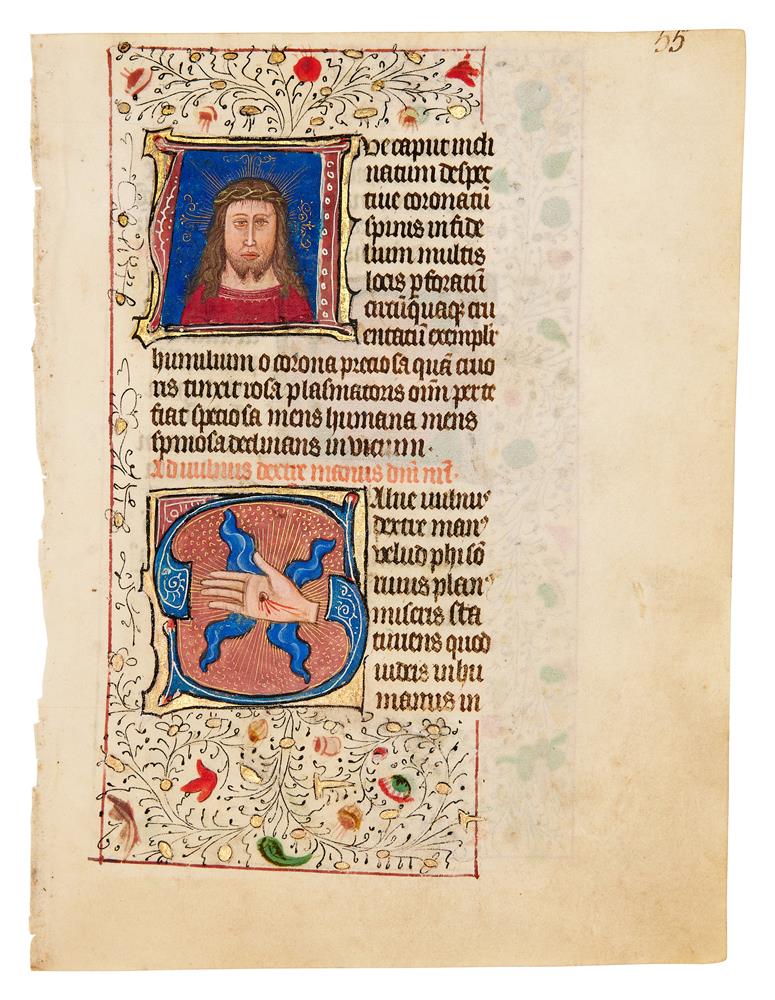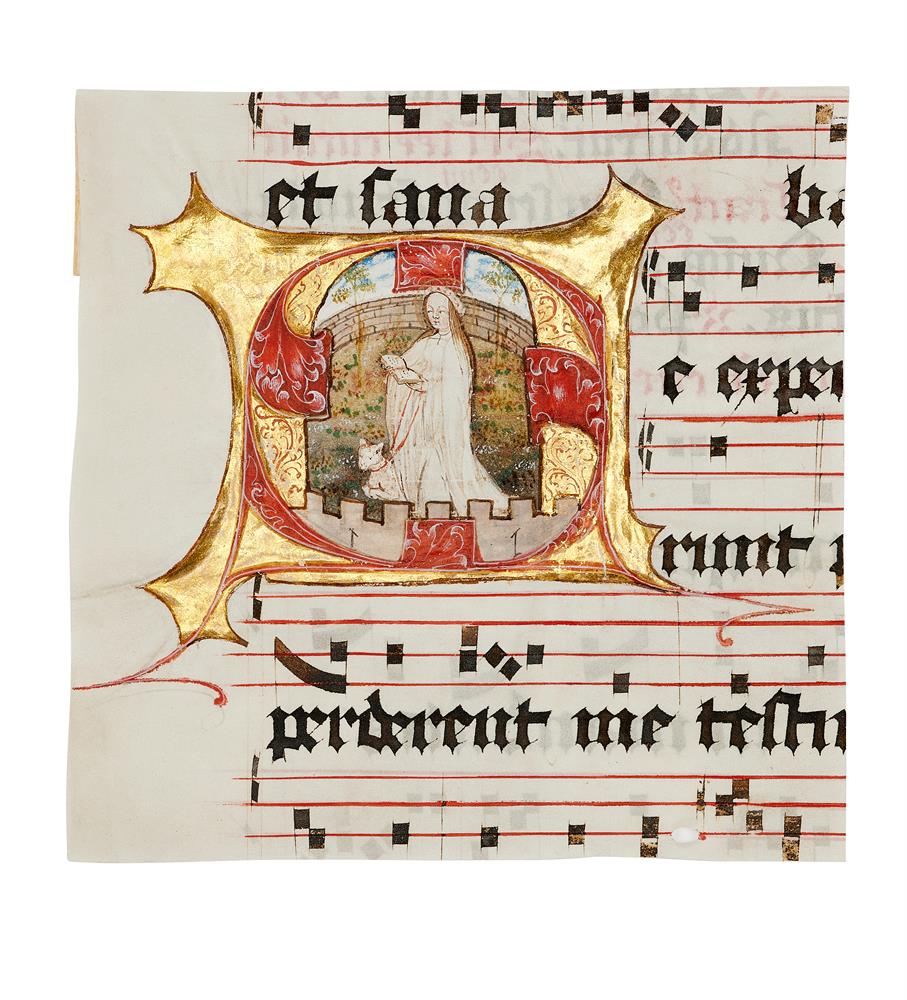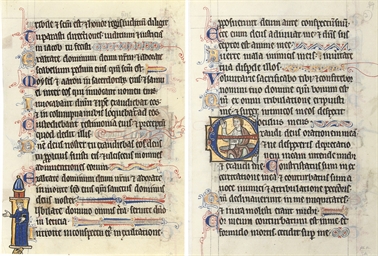TWO LEAVES WITH HISTORIATED INITIALS FROM A MIDDLE ENGLISH BRUT CHRONICLE, in Middle English prose, illuminated manuscript on vellum [London, c.1430s
TWO LEAVES WITH HISTORIATED INITIALS FROM A MIDDLE ENGLISH BRUT CHRONICLE, in Middle English prose, illuminated manuscript on vellum [London, c.1430s] Two rediscovered leaves from a lavishly illustrated Middle English Brut Chronicle, of paramount importance to the study of English illumination. The Brut Chronicle was a prose history of England from its mythical founder Brutus, grandson of Aeneas, with continuations to 1377 and 1419. A hugely popular text in the 15th century, it was seldom illustrated. PROVENANCE : The two fragments are the missing ff.16 and 18 from a Brut Chronicle sold at Sotheby’s, 18-19 April 1932, lot 8. The parent manuscript was written by three separate scribes and was almost certainly produced in London in the second quarter of the 15th century. Evidence in the parent manuscript shows that it was in Scotland in the 16th century and in Spain in the 17th or 18th century. It then passed to the O’BRIEN FAMILY , Earls of Inchiquin, perhaps to Lucius McEdward O'Brien, 13th Baron Inchiquin (1800-1872). Subsequently it was owned by MAJOR E. W. MACDONALD of Dedham, Essex, and sold at his sale at Sotheby’s on 18-19 April 1932, lot 8 to Myers and Co. (their catalogue 291, 1933, no 299). It is perhaps at this point that the present fragments, among others, were removed: three are now preserved in Lehigh University Library (exhibition catalogue by J. Hirsch, Western Manuscripts of the Twelfth Through the Sixteenth Centuries in the Lehigh University Libraries , 1970 – the present fragments have been cut to a similar square shape). The bulk of the manuscript was purchased by JULIUS WANGENHEIM (1866-1942), of San Diego and passed by descent to his grandson Robert G. Heyneman. One leaf was left to M.H. Kittredge. Kathleen Scott’s description of the content of the Heyneman manuscript lists the present fragments as missing. CONTENT : (1) The fragment of f.16 begins in Ch. XXXVIII ‘[...] lande in moche pr[os]p[e]r[i]te’ and ends in Ch. XL ‘This kyng Armoger regnede wel and worthyly [and] ye lande wel governed. And Claudius Cesar in [...]. (2) The fragment of f.18 begins in Ch. XLIV ‘[...] forto baptise children [...]’ and ends in Ch. XLVII ‘After kyng Constances deth Constantyn his sone [...]’. The text of the Heyneman manuscript is discussed by L. Matheson, The Prose Brut: The Development of a Middle English Chronicle , 1998, pp. 119-21. ILLUMINATION : The style of illumination follows the conventions of English ‘metropolitan’ book decoration of the second quarter of the 15th century: the faces are roughly modelled in white with spots of red to mark the nose and mouth; the palette is one of bright greens, pinks, reds and blues, with gold and white accents. But the results here are far more elegant and lively. Kathleen Scott links the Heyneman illustrator to a Psalter in the British Library, Royal 2. B. X. – also made in London – and BL MS. Harley Charters 51.H.6. There are also strong stylistic similarities to the illustrations in Bodleian Library MS. Douce 18, and to the initial of Richard II (f. 248) in a Statuta Antiqua , London, Guildhall Records Office (see K.L. Scott Later Gothic Manuscripts , 1996, II, no 77, pp. 223-25). The subjects of the historiated initials are as follows: King Ginder, son of Cymbeline, opening Ch. XXXIX (originally f.16 of the Heyneman manuscript); King Armoger, father of Westmer, opening Ch. XL (originally f.16v of the Heyneman manuscript); Constantine the Great, son of Helena, opening Ch. XLVII (originally f.18v of the Heyneman manuscript). PHYSICAL DESCRIPTION AND CONDITION : Two fragments of two leaves, 189 x 200mm and 220 x 210mm. 20 and 21 lines (of originally 36) in two columns, small initials in blue with red penwork, rubrics in red, one illuminated initial and THREE HISTORIATED INITIALS (both fragments cropped to a square at the top, with strips of vellum from the tops of the leaves – including pencil foliation 16 and 18 – pasted on, light smudging to historiated initials
TWO LEAVES WITH HISTORIATED INITIALS FROM A MIDDLE ENGLISH BRUT CHRONICLE, in Middle English prose, illuminated manuscript on vellum [London, c.1430s
TWO LEAVES WITH HISTORIATED INITIALS FROM A MIDDLE ENGLISH BRUT CHRONICLE, in Middle English prose, illuminated manuscript on vellum [London, c.1430s] Two rediscovered leaves from a lavishly illustrated Middle English Brut Chronicle, of paramount importance to the study of English illumination. The Brut Chronicle was a prose history of England from its mythical founder Brutus, grandson of Aeneas, with continuations to 1377 and 1419. A hugely popular text in the 15th century, it was seldom illustrated. PROVENANCE : The two fragments are the missing ff.16 and 18 from a Brut Chronicle sold at Sotheby’s, 18-19 April 1932, lot 8. The parent manuscript was written by three separate scribes and was almost certainly produced in London in the second quarter of the 15th century. Evidence in the parent manuscript shows that it was in Scotland in the 16th century and in Spain in the 17th or 18th century. It then passed to the O’BRIEN FAMILY , Earls of Inchiquin, perhaps to Lucius McEdward O'Brien, 13th Baron Inchiquin (1800-1872). Subsequently it was owned by MAJOR E. W. MACDONALD of Dedham, Essex, and sold at his sale at Sotheby’s on 18-19 April 1932, lot 8 to Myers and Co. (their catalogue 291, 1933, no 299). It is perhaps at this point that the present fragments, among others, were removed: three are now preserved in Lehigh University Library (exhibition catalogue by J. Hirsch, Western Manuscripts of the Twelfth Through the Sixteenth Centuries in the Lehigh University Libraries , 1970 – the present fragments have been cut to a similar square shape). The bulk of the manuscript was purchased by JULIUS WANGENHEIM (1866-1942), of San Diego and passed by descent to his grandson Robert G. Heyneman. One leaf was left to M.H. Kittredge. Kathleen Scott’s description of the content of the Heyneman manuscript lists the present fragments as missing. CONTENT : (1) The fragment of f.16 begins in Ch. XXXVIII ‘[...] lande in moche pr[os]p[e]r[i]te’ and ends in Ch. XL ‘This kyng Armoger regnede wel and worthyly [and] ye lande wel governed. And Claudius Cesar in [...]. (2) The fragment of f.18 begins in Ch. XLIV ‘[...] forto baptise children [...]’ and ends in Ch. XLVII ‘After kyng Constances deth Constantyn his sone [...]’. The text of the Heyneman manuscript is discussed by L. Matheson, The Prose Brut: The Development of a Middle English Chronicle , 1998, pp. 119-21. ILLUMINATION : The style of illumination follows the conventions of English ‘metropolitan’ book decoration of the second quarter of the 15th century: the faces are roughly modelled in white with spots of red to mark the nose and mouth; the palette is one of bright greens, pinks, reds and blues, with gold and white accents. But the results here are far more elegant and lively. Kathleen Scott links the Heyneman illustrator to a Psalter in the British Library, Royal 2. B. X. – also made in London – and BL MS. Harley Charters 51.H.6. There are also strong stylistic similarities to the illustrations in Bodleian Library MS. Douce 18, and to the initial of Richard II (f. 248) in a Statuta Antiqua , London, Guildhall Records Office (see K.L. Scott Later Gothic Manuscripts , 1996, II, no 77, pp. 223-25). The subjects of the historiated initials are as follows: King Ginder, son of Cymbeline, opening Ch. XXXIX (originally f.16 of the Heyneman manuscript); King Armoger, father of Westmer, opening Ch. XL (originally f.16v of the Heyneman manuscript); Constantine the Great, son of Helena, opening Ch. XLVII (originally f.18v of the Heyneman manuscript). PHYSICAL DESCRIPTION AND CONDITION : Two fragments of two leaves, 189 x 200mm and 220 x 210mm. 20 and 21 lines (of originally 36) in two columns, small initials in blue with red penwork, rubrics in red, one illuminated initial and THREE HISTORIATED INITIALS (both fragments cropped to a square at the top, with strips of vellum from the tops of the leaves – including pencil foliation 16 and 18 – pasted on, light smudging to historiated initials



.jpg)


.jpg?w=400)





Testen Sie LotSearch und seine Premium-Features 7 Tage - ohne Kosten!
Lassen Sie sich automatisch über neue Objekte in kommenden Auktionen benachrichtigen.
Suchauftrag anlegen